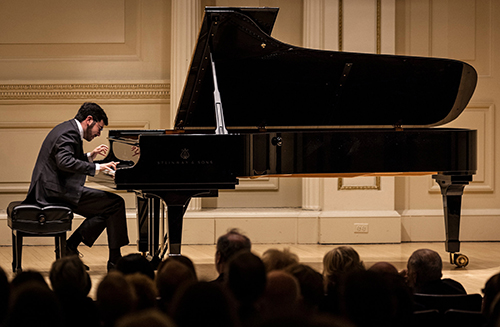By Allan Kozinn, The New York Times
April 11, 2012
» Original Link » PDF

Michael Brown, a pianist and composer fresh out of the Juilliard School, has made a strong impression in recent seasons in chamber music and as a concerto soloist. This month he collects a couple of prizes that each include a recital.
As the winner of the 2010 Concert Artists Guild Victor Elmaleh Competition, he played a hefty, stylistically varied program at Weill Recital Hall on Tuesday evening. The hall was packed, and musicians were plentiful, usually a sign that a young performer is worth watching, and that proved to be the case. Mr. Brown has a streamlined but powerful technique and a vivid imagination. If you missed him this time, you might consider catching his recital at Alice Tully Hall on April 23, which he is giving as the winner of the Juilliard School Petschek Piano Recital Award.
Mr. Brown established his strengths immediately in sharply articulated readings of two Soler sonatas, works that occupy a middle ground between Scarlatti and Mozart but make unusual demands of their own. The repeated-note figures in the Sonata in D flat (R. 88), for example, point to a later era, and benefitted from Mr. Brown’s steady, jackhammer execution.
In terms of color the Soler works were limited, but this was clearly an interpretive choice, Mr. Brown’s concession to current notions of 18th-century sonority, which he otherwise made little effort to approximate. He demonstrated his strengths as a colorist later in the evening, in supple accounts of Spanish-accented works by Debussy (“La Puerta del Vino” and “La Soirée Dans Grenade”) and Ravel (“Pièce en Forme de Habanera” and “Alborada del Gracioso”), and in vigorous, richly detailed renderings of three pieces from Liszt’s “Années de Pèlerinage: Suisse.”
Mr. Brown’s adventures in the standard canon also included a muscular performance of Beethoven’s Sonata No. 22 in F (Op. 54), enlivened by a balance of the precision that he brought to the Soler and the nuance that kept his Debussy, Ravel and Liszt so appealingly fluid.
But the real draws were a pair of new additions to the repertory. One, George Perle’s “Classic Suite” (1938), is actually an old work that Mr. Brown and Shirley Perle, the composer’s widow, recently discovered in a box of unpublished manuscripts. Cast in the rhythms of Baroque dances (an Allemande, Courante, Sarabande, Gavotte and Gigue) but couched in a mildly dissonant harmonic language, the suite is a lively dialogue between eras, with a touch of the lyricism that would distinguish Perle’s later music.
Mr. Brown played it with energy and clarity, qualities he also applied to his own rugged “Constellations and Toccata” (2012), a work with a spare, atmospheric opening movement that gives way to a sizzling perpetual-motion finale. He read both works from an iPad, and he is repeating his own piece at his next recital.
© Michael Brown, All Rights Reserved. Site by ycArt design studio